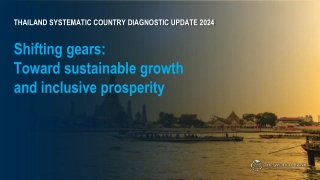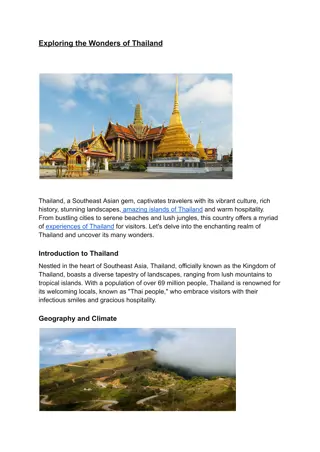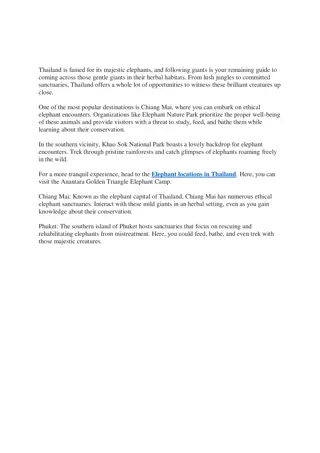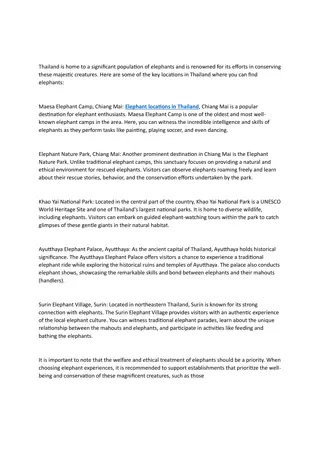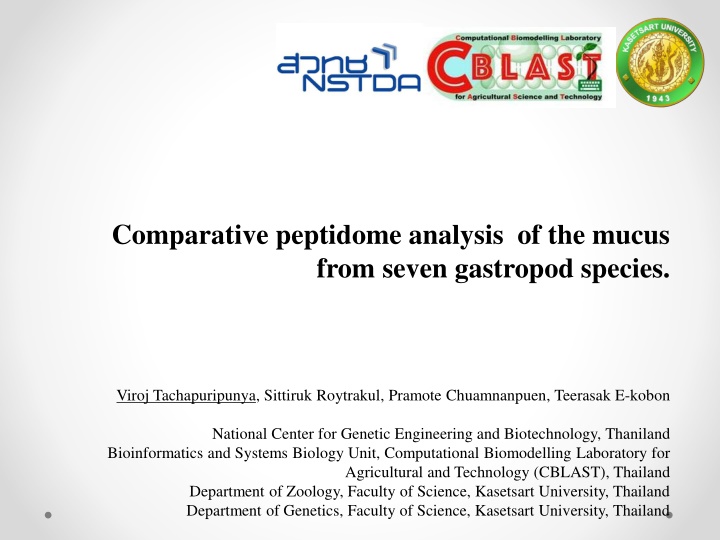
Comparative Peptidome Analysis of Gastropod Mucus
Explore the mucus composition of seven gastropod species through comparative peptidome analysis, shedding light on potential bioactive molecules and applications in pharmaceutical, medical, and cosmetic products. The study aims to extract mucus and characterize peptidomes from the mucus of various gastropods, providing valuable insights into their unique properties and potential benefits.
Uploaded on | 0 Views
Download Presentation

Please find below an Image/Link to download the presentation.
The content on the website is provided AS IS for your information and personal use only. It may not be sold, licensed, or shared on other websites without obtaining consent from the author. If you encounter any issues during the download, it is possible that the publisher has removed the file from their server.
You are allowed to download the files provided on this website for personal or commercial use, subject to the condition that they are used lawfully. All files are the property of their respective owners.
The content on the website is provided AS IS for your information and personal use only. It may not be sold, licensed, or shared on other websites without obtaining consent from the author.
E N D
Presentation Transcript
Comparative peptidome analysis of the mucus from seven gastropod species. Viroj Tachapuripunya, Sittiruk Roytrakul, Pramote Chuamnanpuen, Teerasak E-kobon National Center for Genetic Engineering and Biotechnology, Thaniland Bioinformatics and Systems Biology Unit, Computational Biomodelling Laboratory for Agricultural and Technology (CBLAST), Thailand Department of Zoology, Faculty of Science, Kasetsart University, Thailand Department of Genetics, Faculty of Science, Kasetsart University, Thailand
Introduction - Snails and Slugs - Phylum Mollusca, Class Gastropoda - Various habitats - Quick adaptation and reproduction - Some are agricultural pests . - Mucus - Sticky and resilience like glue - help snails and slugs locomotion, defense against infection, etc. - Within-species communication and reproductive attraction (Chase, 2007) - Wound-healing properties on damaged shells (Wagge, 1951) Achatina fulica Semperula siamensis and Cryptozona siamensis Pomatia canaliculata Ref: https://upload.wikimedia.org http://www.siamensis.org http://axcela.lonza.com/
Introduction - Mucus composition - Mostly water with proteins, carbohydrates, and minerals - Several bioactive molecules: achatinin, mytimacin-AF, etc. (Biwas et al., 2000) -Applications in pharmaceutical medical and cosmetic products Do mucus secreted from different gastropod species have peptides or proteins in common? Cyclophorus fulguratus Ref : http://www.discoverlife.org http://s568.photobucket.com https://upload.wikimedia.org Hemiplecta distincta Helix pomatia
Objective To extract mucus and characterize peptidomes from the mucus of seven gastropod species.
Materials and Methods Separation of the mucus samples by 1D-SDS- PAGE Gel image analysis by Gel analyzer Program Gastropod mucus extraction Mucus protein quantification Lowry assay 1 4 Peptide identificati on by LC- MS/MS Comparative peptidome analysis using R In-gel trypsin digestion 7 5
Materials and Methods: Gastropod samples - 5 Heterobranchs & 2 Caenogastropods - Samples were washed and cleaned before mucus extraction. Group No Scientific name Place of collection A garden at Faculty of Science, Kasetsart University, Bangkok, Thailand 1 Achatina fulica Heterobranchia A canal near Faculty of Science, Kasetsart University, Bangkok, Thailand 2 Pomacea canaliculata Caenogastropoda 3 Cryptozona siamensis Sakaerat Environmental Research Station Sakaerat Biosphere Reserves, Nakhon Ratchasima, Thailand Heterobranchia 4 Semperula siamensis Heterobranchia A tree shop, Patumthani, Thailand Chet Khot-Pong Kon Sao Nature Study Centre, Saraburi, Thailand 5 Hemiplecta distincta Heterobranchia 6 Cyclophorus fulguratus Sakaerat Environmental Research Station Sakaerat Biosphere Reserves, Nakhon Ratchasima, Thailand Caenogastropoda 7 Helix pomatia Heterobranchia A garden in Lisbon, Portugal
Materials and Methods: Gastropod mucus extraction by gently disrupt the foot tissue 1-2 ml of distill water
Results: Mucus protein contents - - Average protein concentration from seven gastropod species is 1.44 g/ l. The mucus of Semperula siamensis had the highest protein concentration. HP Gastropod species CF HD SS CS PC AF 0 0.5 1 1.5 2 2.5 Protein concentration ( g/ l)
Results: gastropod mucus separated on 1D SDS gels - - - Different band patterns across seven species Mucus from the same snail species had highly similar band profiles. More bands appeared after silver staining.
Results: Gel image analysis of mucus band patterns - Gel image analysis by GelAnalyzer program showed different numbers of protein bands and intensity.
Results: Peptides identified from gastropod mucus - 2,820 peptides were founded in total and 1,317 peptides shared between these seven gastropod species. 2,800 2,700 2,600 Peptide sequence AF = Achatina fulica PC = Pomacea canaliculata CS = Cryptozona siamensis SS = Semperula siamensis HD = Hemiplecta distincta CF = Cyclophorus fulcuratus HP = Helix pomatia 2,500 2,400 2,300 2,200 2,100 AF PO CS SS HD CF HP Gastropod species
Results: Properties of the identified peptides - Several short peptides were identified with similarphysicochemical properties. peptide number 2731 2415 2360 2415 2404 2393 2396 average mass 888.3253 877.3349 873.5107 881.6808 869.2819 874.6917 874.9594 average length 8.277554 8.172257 8.14322 8.209524 8.103577 8.151275 8.156093 average hydrophobicity 145.413 143.2505 142.9225 143.6244 143.2113 142.9068 141.9366 average + charged 2.654339 2.615321 2.618644 2.65383 2.604825 2.618471 2.641903 average - charged 0.732699 0.718427 0.722458 0.726294 0.702995 0.715838 0.715359 AF PC CS SS HD CF HP
Results: Clustering of mucous peptide patterns - After removing the peptidesfound in all species, clustering unique peptides showed different peptide patterns across the seven gastropods species. These peptide patterns might be used to distinguish different gastropod species. - peptides CS HP CF PC HD SS AF Gastropod species
Discussions - The mucus extracted from seven gastropod species showed different band patterns on SDS-Polyacrylamide gels confirmed by the MS-identified peptides. - Common peptides could play important roles as part of the core mucous proteins or being constituent of the proteoglycans in the mucus. - Variable peptides could be part of unique mucous proteins secreted from the protein glands or from different food sources. More genome information on these gastropods will confirm this findings.
Conclusion - This study successfully extracted and characterized the mucus from seven gastropod species. - SDS-PAGE separation and MS-peptide sequencing identified common and variable peptides from the mucus of seven gastropod species. - The peptide patterns might be used to identify gastropod species from the mucus source. Their bioactive properties will be further characterized for future medical and cosmetic applications.
References - Chase, R., The function of dart shooting in helicid snails. American Malacological Bulletin, 2007. 23(1): p. 183-189. - WAGGE, L.E., The Activity of Amoebocytes and of Alkaline Phosphatases during the Regeneration of the Shell in the Snail, Helix aspersa. Quarterly Journal of Microscopical Science, 1951. s3-92(19): p. 307-321. - Biswas, C., D. Sinha, and C. Mandal, Investigation on interaction of Achatinin, a 9-O-acetyl sialic acid-binding lectin, with lipopolysaccharide in the innate immunity of Achatina fulica snails. Mol Immunol, 2000. 37(12-13): p. 745-54.
Acknowledgements Dr.Teerasak E-kobon Dr.Pramote Chuamnanpuen Dr.Sittiruk Roytrakul - Do Day Dream Co., Ltd., Bangkok, Thailand - National Center for Genetic Engineering and Biotechnology, Thailand - Bioinformatics and Systems Biology Unit, Computational Biomodelling Laboratory for Agricultural and Technology (CBLAST), Kasetsart University, Thailand - Department of Zoology, Faculty of Science, Kasetsart University, Thailand - Department of Genetics, Faculty of Science, Kasetsart University, Thailand

